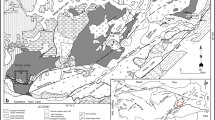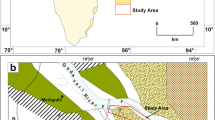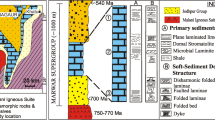Abstract
Mass-transport deposits (MTDs) are well developed on the slope of the Eocene Sobrarbe delta (Ainsa Basin, Spanish Pyrenees) and are studied in order to improve the understanding of soft sediment deformation in MTDs. The five examples illustrate the distinction between the extensional zone and the compressional domain. The upslope domain is illustrated by a set of three stacked nummulite-rich slid layers. They are deformed by load structures suggesting density inversion and sinking of nummulite gravel down into the underlying silty-shaly material. Post-sliding deformation is evidenced from small-scale roll-overs, neptunian dykes and syn-sedimentary normal faults. Slow extensive deformation has continued in the substratum of the scar after the main sliding episode. Soft-sediment deformation is less obvious in large displaced blocks where deformation is limited at the periphery of the blocks. Imbricate thrusts, formed on the side of a sliding layer, illustrate structures related to displacement. Striations on the thrust planes indicate that sliding occurred along the strike of the imbricate slices. The km scale Castellazo outcrop shows slump folds resting over a basal debris flow.
Access provided by Autonomous University of Puebla. Download chapter PDF
Similar content being viewed by others
Keywords
1 Introduction
Mass-Transport Deposits (MTDs) are commonly recognized in the field from the presence of deformed packages of sediment sandwiched between undeformed strata (Posamentier and Martinsen 2011). MTDs typically comprise an extensional headwall, upslope part, a translation domain and a compressive downslope toe domain (Martinsen and Bakken 1990), with or without distal overspill onto the seabed (Frey-Martinez et al. 2006).
Soft sediment deformation structures (Allen 1982) have been observed in numerous places on delta slopes, they show the variability of deformation styles from the most proximal to the most distal domains of MTDs. In that spirit, five outcrops from the San Vicente Formation (Ainsa basin) illustrate soft sediment deformation structures in MTDs.
2 Geological Setting of Ainsa Basin
The Eocene Ainsa Basin (Spanish Pyrenees) has been formed by flexural subsidence due to the southward propagation of thrusts in the South Pyrenees (Puigdefàbregas et al. 1991) (Fig. 44.1). The Basin has progressively developed towards the north-northwest from late Ypresian to Bartonian, guided by the growth of the Boltaña and Mediano lateral-thrust ramp anticlines. It is structured into a large NNW-SSE open syncline, the upper part of which is filled by the infilling of the Sobrarbe delta (Dreyer et al. 1999).
(a) General location of the Ainsa Basin , Spanish Pyrenees (Redrawn from Dreyer et al. 1999). (b) Transition between Guara Limestone and San Vicente formations (Redrawn from Razin et al. 2010). Stars refer to the approximate position of: (1) Nummulite outcrop ; (2) Extensional structures; (3) Castellazo MTD
The Ainsa Basin fill is composed of marls and turbidites (Fig. 44.1). The main source area was located in the rising Pyrenean orogen on the NE margin. A minor source is the carbonate platform located on the SW margin. Numerous MTDs are observed (Pickering and Corregidor 2005), in the deeper part of the basin as well as on the coeval slope where numerous submarine gravitational scars of m- to km-scale are observed in each sequence.
3 Deformation in the Proximal Part of MTDs
The first example is near an upslope scar located west of Santa Maria de Buil. Soft sediment deformation structures can be observed in the infill of the S4 scar surface of Callot et al. (2009). The background sedimentation consists of a 5-m-thick siltstone succession with two interbedded nummulite-rich layers. This succession is replaced in the study area by three units showing a complex mix of silt and nummulites (Mateu-Vicens et al. 2012). It is exposed on both flanks of a small E-W ridge but all three units are about 1.5 times thicker on the northern flank.
The top of each unit is flat and it is made of poorly-sorted nummulite-rich gravel (Fig. 44.2). Unit 1, at the base, shows a complex mix of contorted silt blocks and nummulite-rich “blades” or wedges. Unit 2 is less deformed: the two types of sediments are organized as large scale load structures, nummulite-rich pockets hanging down, some of them attached to the layer by a thin oblique alignment of small nummulites. Mixing is less developed in Unit 3 but deformation is pervasive. The proportion of mixed sediment decreases both upward and laterally to the west. Abundant evidence for shearing in the most deformed part of the outcrop (Fig. 44.2b, c) suggests that intense shearing may also be responsible for loss of strength of sediment, thereby promoting soft sediment deformation fueled by density and viscosity contrasts (Owen 2003).
The second of our examples is a proximal MTD that consists of a small-scale extensional structure located in the sole of the S2 scar surface of Callot et al. (2009). The structures are exposed along 130 m of an almost continuous outcrop (Fig. 44.3). Twenty Neptunian dykes, numerous syn-sedimentary normal fault s and some small-scale roll-overs are present in the upper part of the sole of the scar. Neptunian dykes are known as resulting of extensional tectonics in cohesive sediments (Montenat et al. 2007). In the present case they are preserved by coarse-grained sandstones filling the dykes. The same coarse-grained sandstones have filled small-scale half-graben-type structures developed on listric faults. The bases of the sandstone layers are affected by small-scale syn-sedimentary normal faults formed in non-cohesive sediments. When corrected for both the rotation due to the Mediano anticline and that due to the roll-over structures, all the structures show the same NW-SE extension direction (Fig. 44.3). Neptunian dykes form as vertical (Moretti and Sabato 2007) but here, the dykes are curved with their tip bent upslope, suggesting continued downslope shearing.
We propose the following to account for the observations: (1) Neptunian dykes are formed first by stretching, shortly after the major slide above evacuated the overburden; (2) next, small-scale rollover structures formed along m-scale normal fault s and both the dykes and the half grabens are filled by sand; (3) finally, sliding of both the substratum and the first infill continues, as evidenced by the bending of the dykes and the small normal faults that affect the sandstone.
4 Deformation in the Median Part of a MTD
The third of our examples is a set of large blocks resedimented from the distal shelf domain downwards (Fig. 44.4). The thickness of individual blocks ranges from several meters to several tens of meters. All are made up of alternating marl and turbidite layers that provide depositional polarity. The larger blocks comprise up to 38 m of sedimentary series that have been displaced and tilted. The size of the blocks is compatible with that of scars that have mobilized up to 150 m of sedimentary series on the front of the Sobrarbe Delta (Dreyer et al. 1999). The deformation is concentrated at the periphery of every displaced block. Only some of the smaller blocks record a high degree of deformation (Fig. 44.4).
5 Deformation in the Distal Part of MTDs
The Castellazo MTD crops out along a 1 km section and it is about 10 m thick with an increase in thickness in the direction of sliding (Fig. 44.5). The MTD is composed of a stack of three units. Unit 1 at the base is a lenticular debris flow composed of 70 % of bioclastic grainstone debris embedded in 30 % of clayey matrix. Unit 2 is constituted of slumped alternations of silt/sand and claystone (Fig. 44.5a, b). Unit 3 is a homogeneous bioclastic grainstone showing occasional faint stratification. The direction of sliding was deduced from fold axes directions. Many anticlinal hinges are broken by clay injection (Fig. 44.5).
At the base of the grainstone unit, the bedding is parallel to folded beds of Unit 2, indicating that grainstone deposition started before slumping was completed (Fig. 44.5c); in addition, flat bedding at top indicates that grainstone deposition was still active when folding ceased. The basal shear surface ramps up in distal position, and the MTD reaches its maximum thickness just at the back of this ramp. The shortening of Unit 2 is maximum there and grainstone Unit 3 is missing. Unit 3 is interpreted to disappear by onlap on the peripheral bulge of the MTD, where the front of the transported mass emerged onto the seafloor. All these observations show that the MTD was likely emplaced over a short span of time.
Our fifth example consists of a set of imbricate thrust s which are located 1.5 km NW of Santa Maria de Buil in the distal part of the Sobrarbe delta .
The sedimentary succession is composed of alternating silt and marl layers. Two meter-thick levels are affected by imbricate thrust s . Thrust sheets are oriented N052 with a dip of 23° towards the SE (Fig. 44.6). The lower part of every sheet is stretched and thinned while numerous striae may be observed at the base of the sheets. Striae always strike parallel to the thrust sheets, about N050, and examination under scanning electron microscope shows that striae are formed by displacement without formation of any fiber or new mineral. All these observations indicate early sliding of soft sediment parallel to the sheets towards the NE.
These imbricate thrust s are reminiscent of the compressive thrusts described in the distal part of MTDs (Prior et al. 1984) but all indicate, here, the sliding of a single sedimentary layer that deforms when striking a resting boundary.
6 Discussion and Conclusions
The variability of deformation styles observed on these five examples illustrates first the classical distinction between extensional zone and compressional domain, with the first two examples (nummulite mix and rollover) belonging to the former and the last two (Castellazo and imbricate thrust s ) to the latter. The third example with juxtaposed blocks may be considered to represent the translation domain.
The first two examples both come from the most upslope part of two MTDs, with limited interpreted displacement. Deformation in the nummulite mix example affected sediments that had never been buried by more than 1 m, resulting in a very soft style of deformation . On the contrary, the glide of rollover structures affected upon failure of the overburden sediments that had been buried by several tens of meters, resulting in a much more brittle style of deformation with faults and mode 1 fractures i.e. neptunian dykes formed in material having reached a higher degree of compaction and lithification.
The distal end examples show contrasting styles of deformation resulting from the amount of displacement undergone by the resedimented package: the frontally-confined MTD in Santa Maria de Buil shows a very regular pattern of brittle deformation corresponding to a very limited amount of displacement. On the contrary, the frontally-emergent MTD in Castellazo exhibits a much more complex pattern with folding and rotational deformation, as well as some disaggregation of the slumped mass. It would be classified as “frontally confined ” (Frey-Martinez et al. 2006) and it is supposed to have undergone longer displacement.
Trigger mechanisms are difficult to assess. Nevertheless, bowl-shaped load figures of the nummulite mix outcrop may be interpreted as resulting from seismically triggered soft-sediment deformation structures (Moretti and Sabato 2007). Slumps are driven by gravity (Mastrogiacomo et al. 2012) and soft-sediment deformation structures are favoured by undercompaction of sediments. The high sedimentation rate of the Sobrarbe delta supports these two conditions.
References
Allen JRL (1982) Sedimentary structures, their character and physical basis. In: Developments in sedimentology, 30B, vol II, Chapter 9, Soft-sediment deformation structures. Elsevier, Amsterdam, pp 343–393, 663 p
Callot P, Odonne F, Debroas EJ, Maillard A, Dhont D, Basile C, Hoareau G (2009) Three-dimensional architecture of submarine slide surfaces and associated soft-sediment deformation in the Lutetian Sobrarbe deltaic complex (Ainsa, Spanish Pyrenees). Sedimentology 56:1226–1249
Dreyer T, Corregidor J, Arbues P, Puigdefàbregas C (1999) Architecture of the tectonically influenced Sobrarbe deltaic complex in the Ainsa Basin, northern Spain. Sediment Geol 127:127–169
Frey-Martínez J, Cartwright J, James D (2006) Frontally emergent vs. frontally confined submarine landslides: a 3D seismic characterization. Mar Pet Geol 23:585–604
Martinsen OJ, Bakken B (1990) Extensional and compressional zones in slumps and slides in the Namurian of County Clare, Ireland. J Geol Soc Lond 147:153–164
Mastrogiacomo G, Moretti M, Owen G, Spalluto L (2012) Tectonic triggering of slump sheets in the upper cretaceous carbonate succession of the Porto Selvaggio area (Salento peninsula, southern Italy): sedimentary tectonics in the Apulian carbonate platform. Sediment Geol 269–270:15–27
Mateu-Vicens G, Pomar L, Ferràndez-Cañadel C (2012) Nummulitic banks in the upper Lutetian ‘Buil level’, Ainsa basin, South central Pyrenean zone: the impact of internal waves. Sedimentology 59:527–552
Montenat C, Barrier P, Ott d’Estevenou P, Hibsch C (2007) Seismites: an attempt at critical analysis and classification. Sediment Geol 196:5–30
Moretti M, Sabato L (2007) Recognition of trigger mechanisms for soft-sediment deformation in the Pleistocene lacustrine deposits of the Sant’Arcangelo basin (Southern Italy): seismic shock vs. overloading. Sediment Geol 196:31–45
Owen G (2003) Load structures: gravity-driven sediment mobilization in the shallow subsurface. In: Van Rensbergen P, Hillis RR, Malman AJ, Morley CK (eds) Subsurface sediment mobilization, Special Publication 216. The Geological Society, London, pp 21–34
Pickering KT, Corregidor J (2005) Mass-transport complexes (MTCs) and tectonic control on basin-floor submarine fans, Middle Eocene, south Spanish Pyrenees. J Sed Res 75:761–783
Posamentier HW, Martinsen OJ (2011) The character and genesis of submarine mass-transport deposits: insights from outcrop and 3D seismic data. In: Shipp RC, Weimer P, Posamentier HW (eds) Mass-transport deposits in deepwater settings, Special Publication 96. SEPM Society for Sedimentary Geology, Tulsa, pp 7–38
Prior DB, Bornhold BD, Johns MW (1984) Depositional characteristics of a submarine debris flow. J Geol 92:707–727
Puigdefàbregas C, Muñoz JA, Verges J (1991) Thrusting and foreland basin evolution in the southern Pyrenees. In: McClay K (ed) Thrust tectonics. Chapman & Hall, London, pp 247–254
Razin P, Grélaud C, Odonne F, Debroas EJ (2010) Les systèmes de dépôt tertiaires de la bordure méridionale du bassin sud-pyrénéen dans la Sierra de Guara. RST Bordeaux 2010, Livret d’excursion ASF-AGSO. ISBN 2-907205-66-8
Acknowledgements
This work has been supported by TOTAL. This paper benefitted from constructive reviews by Dr. Massimo Moretti and Dr. Samantha Clarke.
Author information
Authors and Affiliations
Corresponding author
Editor information
Editors and Affiliations
Rights and permissions
Copyright information
© 2016 Springer International Publishing Switzerland
About this chapter
Cite this chapter
Butault, C., Fedorik, J., Odonne, F., Imbert, P. (2016). Soft-Sediment Deformation Associated with Mass Transport Deposits of the Ainsa Basin (Spanish Pyrenees). In: Lamarche, G., et al. Submarine Mass Movements and their Consequences. Advances in Natural and Technological Hazards Research, vol 41. Springer, Cham. https://doi.org/10.1007/978-3-319-20979-1_44
Download citation
DOI: https://doi.org/10.1007/978-3-319-20979-1_44
Publisher Name: Springer, Cham
Print ISBN: 978-3-319-20978-4
Online ISBN: 978-3-319-20979-1
eBook Packages: Earth and Environmental ScienceEarth and Environmental Science (R0)










